Such an amazing and familiar square. It is symmetrical about its center and the axes drawn along the diagonals and through the centers of the sides. And to look for the square area or its volume is not at all difficult. Especially if the length of its side is known.
A few words about the figure and its properties
The first two properties are related to the definition. All sides of the figure are equal to each other. After all, a square is a regular quadrangle. Moreover, he must have all sides equal and the angles have the same value, namely - 90 degrees. This is the second property.
The third is related to the length of the diagonals. They also turn out to be equal to each other. Moreover, they intersect at right angles and at midpoints.
Formula that uses only side length
First about the designation. For the length of the side, it is customary to choose the letter “a”. Then the square area is calculated by the formula: S \u003d a 2.
It is easily obtained from the one that is known for the rectangle. In it, the length and width are multiplied. In a square, these two elements are equal. Therefore, a square of this one quantity appears in the formula.
The formula in which the length of the diagonal appears
She is a hypotenuse in a triangle whose legs are the sides of the figure. Therefore, we can use the formula of the Pythagorean theorem and derive an equality in which the side is expressed through the diagonal.
Having carried out such simple transformations, we find that the square area through the diagonal is calculated by the following formula:
S \u003d d 2/2. Here, the letter d denotes the diagonal of the square.
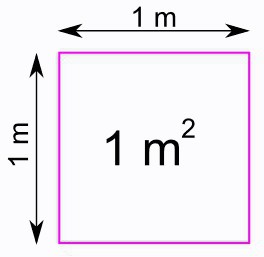
Perimeter formula
In such a situation, it is necessary to express the side through the perimeter and substitute it in the area formula. Since the figure has four identical sides, the perimeter will have to be divided by 4. This will be the value of the side, which can then be substituted into the initial one and count the square area.
The formula in general looks like this: S \u003d (P / 4) 2.
Settlement Tasks
No. 1. There is a square. The sum of its two sides is 12 cm. Calculate the area of \u200b\u200bthe square and its perimeter.
Decision. Since the sum of the two sides is given, you need to find out the length of one. Since they are the same, the known number must simply be divided into two. That is, the side of this figure is 6 cm.
Then its perimeter and area are easily calculated using the above formulas. The first is 24 cm, and the second is 36 cm 2.
Answer. equals 24 cm, and its area is 36 cm 2.

Number 2. Find out the area of \u200b\u200bthe square with a perimeter equal to 32 mm.
Decision. Simply substitute the perimeter value in the above formula. Although you can first find out the side of the square, and only then its area.
In both cases, the actions will first be divided, and then Simple calculations lead to the fact that the area of \u200b\u200bthe presented square is 64 mm 2.
Answer.The required area is 64 mm 2.
No. 3. The side of the square is 4 dm. Rectangle sizes: 2 and 6 dm. Which of these two figures has a larger area? How much?
Decision. Let the side of the square be marked with the letter a 1, then the length and width of the rectangle a 2 and 2. To determine the area of \u200b\u200bthe square, the value of a 1 is supposed to be squared, and the rectangle is multiplied by a 2 and 2. It's not hard.
It turns out that the area of \u200b\u200bthe square is 16 dm 2, and the rectangle is 12 dm 2. Obviously, the first figure is larger than the second. This despite the fact that they are equal, that is, they have the same perimeter. For verification, you can count the perimeters. At the square, the side needs to be multiplied by 4, we get 16 dm. Fold the sides of the rectangle and multiply by 2. It will be the same number.
In the task it is still necessary to answer how many areas differ. To do this, less is subtracted from the larger number. The difference is 4 dm 2.
Answer. The areas are 16 dm 2 and 12 dm 2. At the square, it is 4 dm 2 more.
Proof task
Condition. A square is built on an isosceles leg. To his hypotenuse, the height is built at which another square is built. Prove that the area of \u200b\u200bthe first is twice as large as the second.
Decision. We introduce the notation. Let the leg be equal to a, and the height drawn to the hypotenuse, x. The area of \u200b\u200bthe first square is S 1, the second is S 2.
The area of \u200b\u200bthe square built on the leg is easy to calculate. It turns out to be equal to a 2. With the second value, everything is not so simple.
First you need to know the length of the hypotenuse. For this, the formula of the Pythagorean theorem is useful. Simple transformations lead to this expression: a√2.
Since the height in the isosceles triangle drawn to the base is also the median and the height, it divides the large triangle into two equal isosceles right-angled triangles. Therefore, the height is equal to half the hypotenuse. That is, x \u003d (a√2) / 2. From here it is easy to know the area S 2. It turns out equal to a 2/2.
Obviously, the recorded values \u200b\u200bdiffer exactly twice. And the second one is this number of times less. Q.E.D.
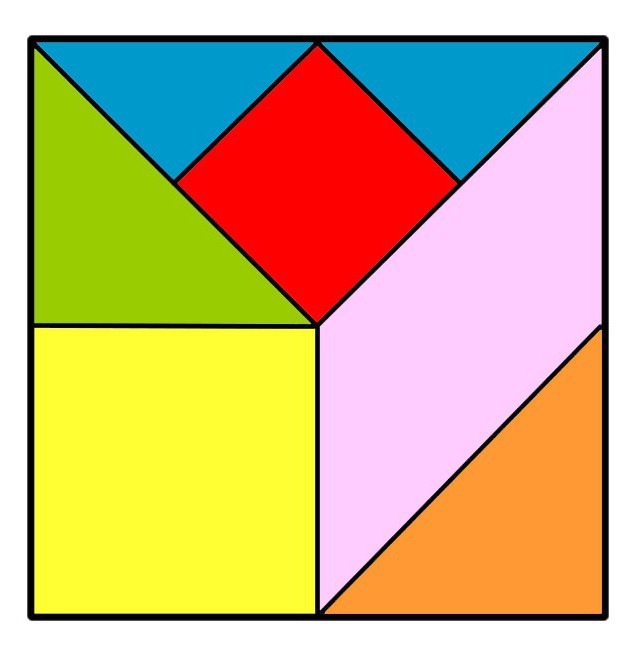
Unusual puzzle - tangram
It is made from a square. It is necessary according to certain rules to cut into various figures. Total parts should be 7.
The rules assume that during the game all the resulting details will be used. From them you need to make other geometric shapes. For example, a rectangle, a trapezoid, or a parallelogram.
But even more interesting is when silhouettes of animals or objects are made from pieces. Moreover, it turns out that the area of \u200b\u200ball derivatives is equal to that of the initial square.
The square area is a basic concept, thanks to which it is possible to calculate the consumption of materials for repairs without problems, calculate the correct dimensions of furniture when measuring a room, and understand how much fertilizer and seeds are needed to plant important crops on a huge field.
The given formulas for the square area are used by builders, furniture manufacturers, and representatives of agriculture.
What is a square?
A square is a regular rectangle with equal sides. Each corner of the figure is 90⁰. A square refers to simple geometric shapes located on a plane. You can find the square area in several ways: on the diagonal, on the side, around the perimeter.
Area formulas, calculation examples
The area of \u200b\u200ba simple figure is a positive value that has the following properties:
- Equal geometric shapes have equal areas.
- If a simple figure is divided into several parts, its total area will always be equal to the sum of the areas of all elements.
- The area of \u200b\u200ba square is always equal to one if its side corresponds to a unit of measurement.
On the side
In geometry, the area is always denoted as S, and small Latin letters (for example, a and b) are the sides of a simple figure.
The calculation of the area of \u200b\u200bany rectangle on the side is based on a simple formula: S \u003d abbut in the case of a square, the formula is converted to S \u003d a²since the two sides are the same in length.

This implies the statement that the area of \u200b\u200ba square is equal to the square of its side.
Example 1: Given a square whose side is 5 cm. What is the area?
Decision: S \u003d 5² \u003d 25 cm
Example 2: The side of the figure is 3 cm. Find the area.
Decision: S \u003d 3² \u003d 9 cm
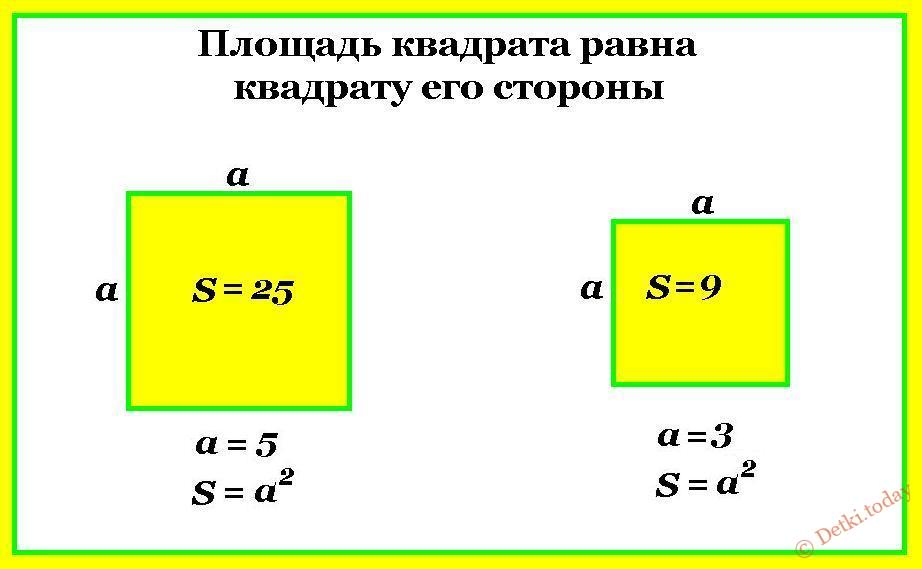
Diagonally
Another option to find the area is to make calculations relative to the diagonal of the figure (d). True, for this you must first find the length of the diagonal itself. It is known that the diagonal divides the square into two isosceles triangles. So, the calculations can be carried out according to the well-known Pythagorean theorem, where the sides of the square will be the legs, and the diagonal itself will be the hypotenuse.

The calculation of the area along the diagonal is carried out according to the principle: the area of \u200b\u200bthe square is equal to the square of the length of the diagonal (calculated by the Pythagorean theorem) and divided by two.
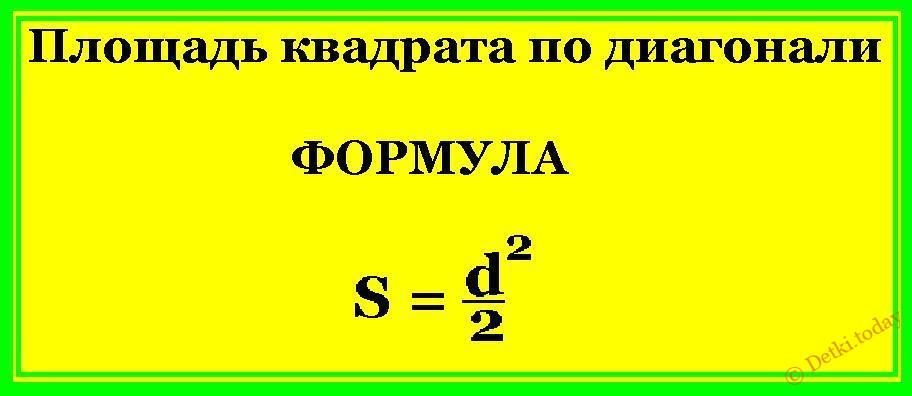
Example: Given a square whose diagonal is 10 cm. How to calculate the area?
Decision: According to the formula above, the calculations are as follows: S \u003d 10² / 2 \u003d 100/2 \u003d 50 cm²
Around the perimeter
Perimeter - the sum of all the lengths of the sides of the square. The perimeter is indicated by the Latin letter R. Taking into account the definition of a square, we obtain a universal formula for calculating the perimeter for an equilateral quadrangle: P \u003d 4a. That is, the perimeter of the square is equal to the length of the side times four.
Calculation of the square area relative to the sum of all sides is necessary if only the perimeter value is specified in the task. Knowing the perimeter calculation formula, it is very easy to find the area.
If a P \u003d 4athen a \u003d P / 4. Next, you already need to use the formula for calculating the area on the side.
Example: Let a square with a perimeter of 100 mm be given. What is the area?
Decision: The side of the square will be 100/4 \u003d 25 mm. Well, the square area is further calculated by the formula, where the square area is equal to the square of the sides. That is, S \u003d 25² \u003d 625 mm²
Area of \u200b\u200ba square inscribed in a circle
This option is used as a consequence of the formula obtained earlier (diagonal calculation). According to mathematical data, the diameter of the circle will be exactly equal to the diagonal square. Therefore, in order to quickly calculate the area of \u200b\u200ban equilateral quadrangle, it will be enough to know the diameter of the circle. And then the well-known formula is used: S \u003d d² / 2
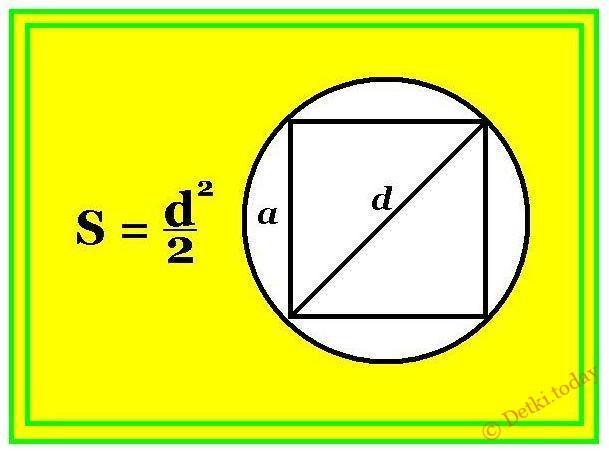
Typical task: for example, a circle with a diagonal of 8 cm is given and a square is inscribed in it. What is the area of \u200b\u200bthe quadrangle?
The right decision: S \u003d 8² / 2 \u003d 64/2 \u003d 32 cm²
Video lesson
Square - This is a regular quadrilateral, in which all sides and angles are equal to each other.
The area of \u200b\u200bthe square is equal to the square of its side:
S \u003d a 2
Evidence
Let's start with the case when a \u003d 1 / n, where n is an integer.
Take a square with side 1 and divide it into n 2 equal squares as shown in figure 1.
Since the area of \u200b\u200ba large square is equal to unity, the area of \u200b\u200beach small square is 1 / n 2. The side of each small square is 1 / n, i.e., equal to a. So,
S \u003d 1 / n 2 \u003d (1 / n) 2 \u003d a 2. (1)
Now let the number a represents a finite decimal fraction containing n decimal places (in particular, the number a can be an integer, and then n \u003d 0). Then the number m \u003d a · 10 n is an integer. We divide this square with side a into m 2 equal squares as shown in Figure 2.
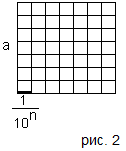
Moreover, each side of this square will be divided into m equal parts, and, therefore, the side of any small square is
a / m \u003d a / (a \u200b\u200b· 10 n) \u003d 1/10 n.
According to the formula (1) the area of \u200b\u200bthe small square is (1/10 n) 2. Consequently, the area S of this square is
m 2 · (1/10 n) 2 \u003d (m / 10 n) 2 \u003d ((a · 10 n) / 10 n) 2 \u003d a 2.
Finally, let the number a is an infinite decimal. Consider the number a nderived from a discarding all decimal places, starting with (n + 1)th. Since the number a differs from a n no more than 1/10 nthen a n ≤ a ≤ a n + 1/10 nfrom where
a n 2 ≤ a 2 ≤ (a n + 1/10 n) 2. (2)
Clear that the area S this square is concluded between the square area with side a n and the square area with side a n + 1/10 n:

i.e. between a n 2 and (a n + 1/10 n) 2:
a n 2 ≤ S ≤ (a n + 1/10 n) 2. (3)
We will increase the number unlimitedly n. Then the number 1/10 n will become arbitrarily small, and, therefore, the number (a n + 1/10 n) 2 will be arbitrarily little different from the number a n 2. Therefore, from the inequalities (2) and (3) it follows that the number S arbitrarily little different from the number a 2. Therefore, these numbers are equal: S \u003d a 2, as required.
Also, the square area can be found using the following formulas:
S \u003d 4r 2,
S \u003d 2R 2,


